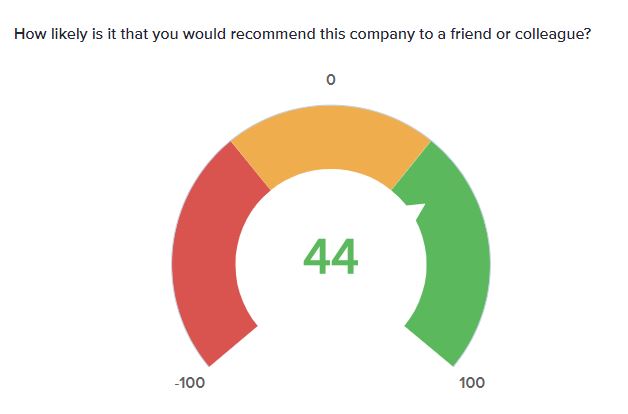If you’re familiar with the customer satisfaction space, you’ll probably have heard of Net Promoter Score, also known as NPS. Simply put, the NPS is an index ranging from -100 to 100, and it measures the willingness of customers to recommend a company’s products or services. Companies use the score to gauge their customers’ satisfaction levels, and determine how loyal they are to the brand.
In this blog post, we walk you through all you need to know about the NPS, including how it came about, how it stacks up against other metrics that measure customer satisfaction, and NPS best practices to keep in mind. Read on to find out more!

The history of Net Promoter Score
The NPS was created by Fred Reichheld, a partner at Bain & Company, back in 2003. Here’s the story: Reichheld realized that conventional customer satisfaction surveys weren’t effective in improving the customer experience, because the results of those surveys didn’t make it back to the front line in a “timely and individualized manner”.
In order to better establish accountability for the customer experience, Reichheld worked with a team from Bain and started researching different approaches that they could use. After testing a variety of questions, they found that the question “What is the likelihood that you would recommend Company X to a friend or colleague?” correlated the best with customer behavior.
To unpack this more: when companies scored highly on this question, more often than not, they would also experience high repurchases, referrals and other actions that contributed to growth. After Reichheld published his findings in a Harvard Business Review article The One Number You Need to Grow, companies started adopting this key metric. Today, the NPS is highly popular, with over two-thirds of Fortune 1000 companies tracking this score.
How much stock do organizations put in NPS?
As mentioned earlier, NPS is an extremely popular metric. Assuming an organization holds customer satisfaction as one of their top priorities, chances are they’re measuring their NPS score, and trying to improve this over time.
What exactly makes NPS so popular? First and foremost, NPS involves just one question; it’s both straightforward and easy to understand. NPS is a key customer service KPI that your team can use to easily gauge customer satisfaction levels, without getting buried under a pile of data. On top of that, the fact that NPS is conveyed in a single number also makes it easy for teams to measure their score, and benchmark it against previous scores.
While Net Prompter Score does bring many advantages to the table, it’s also limited in its own way. Detractors will point out that the score, in itself, doesn’t tell a company how to improve upon their products and processes, or where they’re going wrong. In other words, if you’re simply measuring your NPS without collecting additional qualitative feedback, this won’t prove to be too illuminating for you.
Generally speaking, NPS is favored by enterprise companies and firms in the software/tech industry, where each customer’s lifetime value (LTV) is likely to be tens of thousands of dollars. These companies generally strive to hit higher retention rates, and this makes it all the more important for them to be clued in on what their customers think about them.
Can’t get enough NPS? Read more about The Ultimate Survey Question!
When should you use Net Promoter Score?
When you’re sending out your NPS surveys, remember that timing is key. Ideally, you’ll want to send your survey at a point where customers have used your product/service quite some time now, and are familiar with it. If someone has just signed up as a customer, and you send them a survey right away, they’ll probably respond in a neutral manner — simply because they haven’t had enough time to formulate an opinion about your company yet.
Measuring your NPS: Best Practices
1. Ask a follow-up question
As mentioned earlier, it doesn’t make sense to measure your NPS without collecting additional qualitative feedback. Bearing this in mind, add a follow-up question in your survey to ask your respondents why they’ve given you a particular score. You might also want to ask your respondents what you can do to improve upon your product/service.
2. Send several NPS surveys
Don’t just survey your customers once and call it a day. To use the NPS as a long-term measure of customer loyalty, send out an annual or biannual survey. This way, you can track the movement of your customer’s scores, and gauge how receptive they are to the recent changes that you’ve implemented with your product/service.
3. Respond to both happy and unhappy customers
Many NPS guides out there will tell you that it’s important to respond to your unhappy customers and perform service recovery. This much is obvious. That aside, you should also get in touch with your Promoters, i.e. your happy customers. Go ahead and ask these customers for testimonials or reviews, or even set up a brand ambassador program for them. Never underestimate the power of referral marketing, and word of mouth!
A final word on NPS
Net Promoter Score is a straightforward, easy-to-use metric that you can use to measure customer satisfaction, but how much you get out of this metric really depends on you. Our advice? Instead of doing the bare minimum, follow the best practices that we’ve outlined above, so that you can unlock more insights and make the most out of your NPS scores.














